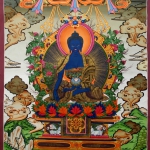Interpreting Buddhist Elder Vajriputra Thangka
Vajriputra is known as the elder is the 5th arhat from the set of 16 great arhats.
Table of Contents
The life of Vajriputra
In this portion, we are going to learn about the life of the Vajriputra, after that, we will learn about the short etymological description of the word Vajriputra.
Etymology of Vajriputra
Vajriputra is known as ne ten, dor Je mo Buin in Tibet. And the meaning of Vajriputra is Sthavira Vajriputra in Sanskrit.
Earlier, we learn about the life of Vajriputra. Now, we are going to learn about the iconography of Vajriputra.
Iconography of the Vajriputra
In the iconography of the Vajriputra, we’ll learn about his body posture, hand and leg gesture, and different representations of Vajriputra in tangka and statue.
Posture of Vajriputra
Vajriputra is mature in visage with close-cropped hair. Vajriputra has a thin mustache and a light growth of facial hair. Vajriputra holds the right hand upraised in a gesture of pointing with the index finger.
The left-arm of Vajriputra is resting across the knee holds in the hand an ornate red fly whisk topped with a tuft of white yak tail hair. Vajriputra is wearing orange patchwork robes with strips of blue cloth and a lower garment of red, the right arm is bare the custom of a Buddhist monk. In a relaxed posture with the legs loosely extended, he sits atop an ornate throne elaborate with a decorative backrest emblazoned with wishing jewels.
The head of Vajriputra is surrounded by a green areola and the background filled with colorful flowering shrubs, pink clouds and a gentle mountain landscape, cascading waterfall, and lotus pond rich with precious wishing jewels, gold ornaments and red coral. The irregular dark green landscape of the foreground is strewn with precious objects and fruit-laden bushes.
Earlier, we learn about the life of Vajriputra and the iconography of Vajriputra. Now, we are going to learn about depicting Vajriputra thangka.
Depicting Buddhist Elder Vajriputra Thangka

The thangka of Vajriputra is from Tibet. It is made between 1700 – 1799 AD. Vajriputra is from Uncertain lineage. The size of the painting is 84.46×55.88cm. The base of the painting is Ground Mineral Pigment on Cotton. Presently, it’s painting is in the Rubin Museum of Art.
By depicting this thanka, we will learn about the presentation of Vajriputri with the goddess.
Goddess
Goddess is at the right of the Vajriputra in the thangka. The goddess is white in color. Goddess is holding aloft a bowl of fresh persimmons on a bed of leaves.
Goddess is Adorned with jewels and gold ornaments, she is attired in variously colored silks and garments. On the Island of Singha is the noble elder Vajriputra who is surrounded by 1,000 arhats. Vajriputra is an homage to the One performing a pointing gesture and holding a fly whisk.
Earlier, we learn about the life of Vajriputra, the iconography of Vajriputra, and depicting Vajriputra thangka. Now, we are going to learn about the presentation of Vajriputra with Dharmata.
Vajriputra with Dharmatala Thangka
The thangka of Vajriputri with Dharmata is from Eastern Tibet. It is made between 1600 – 1699 AD. Vajriputri with Dharmata is from Uncertain lineage. The base of this painting is the Ground Mineral Pigment on Cotton.
By depicting this thangka, we will learn about Vajriputri.
Vajriputra is known as the Elder. In the thangka, the Sixteen Great Arhats are generally painted as a set. Typically the full group would include the buddha Shakyamuni, the 16 arhats, the attendant Dharmatala, the patron Hva-Shang and the Four Guardians of the Directions: Vaishravana, Virupaksha, Dhritarashtra, and Virudhaka.
Earlier, we learn about the life of Vajriputra, the iconography of Vajriputra, and depicting Vajriputra thangka. Finally, we learn about the representation of Vajriputra with Dharmata.










